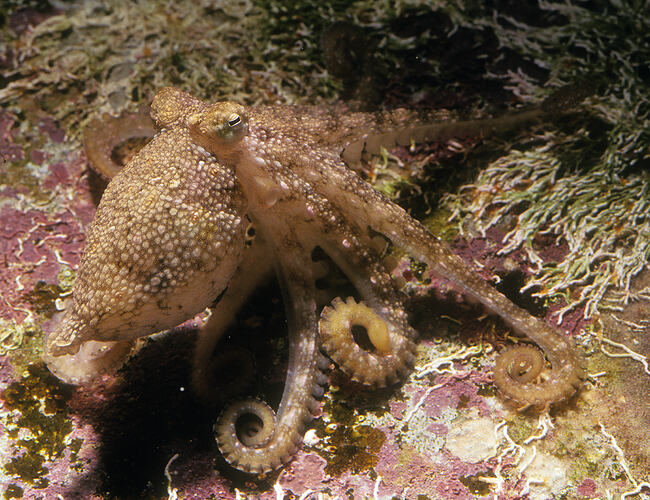General Description
Small, pygmy octopus. Body oval-shaped with pointed rear tip. Resting colour typically orange-brown, may also match purple or pink coralline algae. Alarm pattern of black rings on upper surface of mantle. Male with swollen club tip on the end of third right arm, from which species gets its common name. Mantle length to 4 cm, total length to 13 cm.
Biology
Very little is known about the biology and behaviour of this small octopus. Its small size allows it to remain hidden in the holdfasts of seaweeds and within crevices in rocky reefs and rubble. Females produce numerous small eggs, which hatch into planktonic young. This species has only been observed in the wild a couple of times.
Distribution
New Zealand and south-eastern Australia.
Habitat
Rocky reefs and rubble areas, from intertidal pools to a depth of at least 144 m.
More Information
-
Animal Type
-
Animal SubType
-
Brief Id
Small oval-shaped body, typically orange-brown, black rings on upper surface when alarmed.
-
Colours
Orange, Brown, Purple, Pink, Black
-
Maximum Size
13 cm
-
Habitats
-
Diet
Carnivore
-
Hazards
Potential to bite, especially if handled. Venom status unknown.
-
Endemicity
-
Commercial
No
-
Conservation Statuses
CITES: Not listed, FFG Threatened List: Not listed, DSE Advisory List: Not listed, IUCN Red List: Data Deficient
-
Depths
Shore (0-1 m), Shallow (1-30 m), Deep ( > 30 m)
-
Water Column Locations
On or near seafloor
-
Taxon Name
-
Scientific Author
Stranks, 1990
-
Common Name
Club Pygmy Octopus
-
Phylum
-
Class
-
Subclass
-
Order
-
Suborder
-
Family
-
Genus
-
Species Name
warringa

